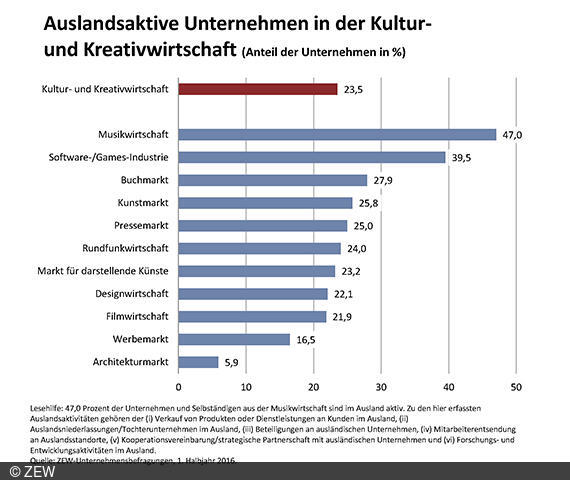Germany's Cultural and Creative Industries See Potential in International Markets
ResearchCompanies in Germany's cultural and creative industries are seeing opportunities to develop their international operations. While barely a quarter of companies in this sector are pursuing core operations abroad, almost one in every two firms is reliant on further kinds of operations overseas. However, a lack of experience and poor management resources as well as a lack of demand for their products are cited as the most common barriers to entering international markets. These are the results of the most recent monitoring report on the state of the cultural and creative industries in Germany regularly compiled by the Mannheim-based Centre for European Economic Research (ZEW) and the Fraunhofer Institute for Systems and Innovation Research (ISI) as part of the Federal government's Cultural and Creative Industries Initiative.
German firms in the creative and cultural industries are using many different channels to position themselves in international markets. Core operations here include the sale of products or services overseas, cooperation or strategic partnerships with foreign companies, and R&D activities abroad. Currently, 24 per cent of companies in the cultural and creative industries are engaged in these activities. Considerably more - around 47 per cent of companies - are pursuing further international operations such as information procurement at trade fairs, conferences or expositions outside of Germany or communications with foreign companies via informal networks.
Out of the companies and self-employed individuals in Germany's cultural and creative sector already active overseas, almost 56 per cent are planning to intensify their international operations over the next two years. Meanwhile, almost 12 per cent of companies not yet active overseas also hope to make the jump and begin operating overseas within the same time frame. The international regions most companies hope to target in these future operations are other German-speaking countries (17 per cent) and other EU countries (18 per cent), followed by the USA and Asia (both 8 per cent), with China being the country of greatest interest.
The government can help by providing market information on target countries
The most commonly cited obstacle keeping German cultural and creative businesses from operating overseas or making current business relations more difficult is, according to around 59 per cent of companies, a lack of experience or management resources when it comes to international operations, alongside a lack of demand for their products and services (also 59 per cent). The high costs associated with entering a new market as well as the difficulty of assessing market risks or potential were also reported by 57 and 55 per cent of companies respectively. There was also a call for government bodies to provide market information on target countries and to offer tips on how to break into the international market.
Alongside the core theme of internationalisation in the cultural and creative industries, the 2016 monitoring report also sheds light on the significance, current state and development of this sector within the German economy as a whole.
For further information please contact:
Dr. Jörg Ohnemus, Phone +49(0)6211235-354, E-mail ohnemus@zew.de
